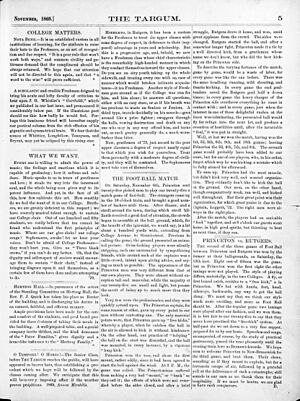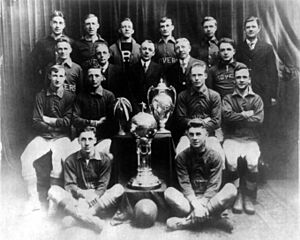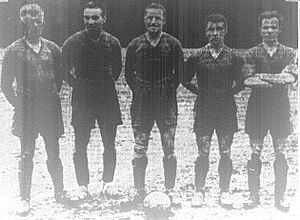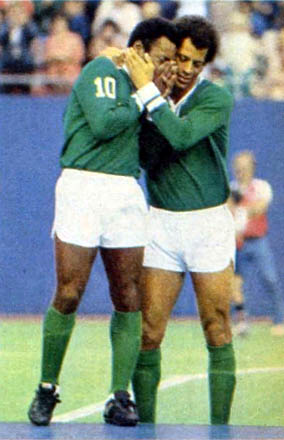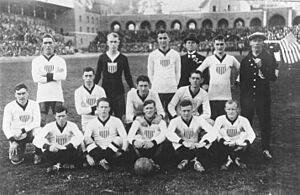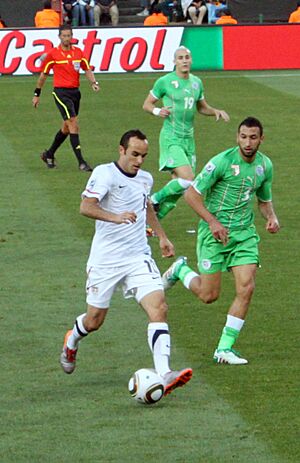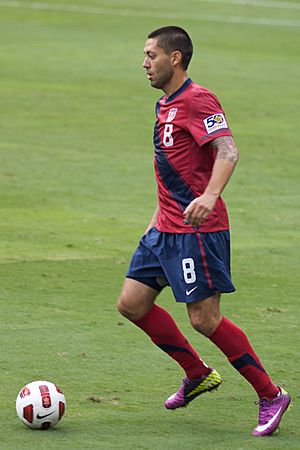History of soccer in the United States facts for kids
Soccer, often called football in other countries, has a long and interesting history in the United States. It first arrived in the 1850s with immigrants from places like Scotland, Ireland, Germany, and Italy. Some of the very first organized games, using the rules we know today, were played in New Orleans.
Men's Soccer History
Early forms of football were played in the U.S. as far back as 1685. These games were often rough and only involved kicking. By the 1860s, different sets of rules started to appear. One was the "Boston game", which mixed parts of rugby and soccer.
Early Club Teams
- Timeline of several known soccer leagues:

Active league Former leagues
Oneida Football Club
The Oneida Football Club was started in 1862 in Boston. Before this, football games didn't have set rules. This made games messy and often violent. The Oneida team was the first organized football team in the U.S. They were very good and reportedly never lost a game.
College Football
The game between Princeton and Rutgers in 1869 is often called the start of college football and soccer in the U.S. It used rules similar to the English Football Association. While American football became popular at many colleges, soccer found fans at places like Haverford College and Columbia University.
The earliest known organized soccer game in the U.S. was on October 11, 1866. It was played in Waukesha, Wisconsin, between Carroll College and Waukesha Town. Carroll won 5–2.
Immigrant Communities and Early Leagues
Soccer grew popular in areas with many immigrants. Towns like Kearny and Paterson had British factories, and their residents formed the National Association Football League in 1895. The Fall River, Massachusetts area also had many English immigrants and its own leagues. In St. Louis, the Catholic Church helped soccer grow through its programs. Other cities where soccer was popular included Chicago, Philadelphia, and Los Angeles.
Early Governing Bodies
Before the United States Soccer Federation (USSF) was created, soccer was organized locally. The first group to try and set national rules was the American Football Association (AFA) in 1884. They wanted to standardize rules for teams in New Jersey and New York.
In 1894, owners of Major League Baseball teams tried to start a professional soccer league to make money in winter. The AFA didn't like this and banned players who joined. This new league failed quickly.
The AFA started the American Cup, the first non-league cup in U.S. soccer. But economic problems and player bans caused it to stop in 1899, restarting in 1906.
In 1911, the American Amateur Football Association (AAFA) was formed. Both the AFA and AAFA wanted to join FIFA, soccer's international governing body. FIFA said only one group could represent the U.S. In 1913, the AAFA became the United States Football Association (USFA). FIFA quickly accepted them. The USFA then started the National Challenge Cup, which soon became more important than the American Cup.
The "Soccer Wars"
In the late 1920s, conflicts called "American Soccer Wars" began. This was a fight between the American Soccer League (ASL) and the USFA over who was in charge of American soccer. This hurt the sport's image. The ASL wanted to run its clubs like baseball teams and didn't like FIFA's rules or the National Challenge Cup.
Some ASL teams were suspended for playing in the Challenge Cup. The USFA then suspended the ASL. This conflict made soccer less popular. The ASL eventually lost the "war" and settled with the USFA in 1929.
The Great Depression and World War II
Soon after the "Soccer Wars" ended, the stock market crashed, leading to the Great Depression. This greatly affected the ASL, and many clubs struggled. The ASL eventually folded in 1932. Even though it was revived, it couldn't attract strong teams. The National Challenge Cup became less known.
During this time, soccer was mostly played by immigrant groups and amateur teams. They hosted a few international matches.
The Second Professional Era
Rise of the NASL
In 1967, two new professional soccer leagues started in the U.S. They merged in 1968 to form the North American Soccer League (NASL). This league lasted until 1984.
Pelé and the New York Cosmos
The most famous team in the NASL was the New York Cosmos. They attracted huge crowds, especially with famous players like Pelé from Brazil and Franz Beckenbauer from Germany. Even though these stars were older, they were still amazing players. The Cosmos sold out Giants Stadium for their 1978 championship win.
NASL Decline and Collapse
The NASL grew too fast, adding many new teams. Many owners didn't understand soccer and left when the sport's popularity seemed to drop. Teams also spent too much money on older stars, trying to be like the Cosmos. This led to big financial losses. The NASL stopped playing on March 28, 1985.
Men's National Team
1930s World Cup
The U.S. team finished third in the 1930 FIFA World Cup in Uruguay. They beat Belgium and Paraguay 3–0. Bert Patenaude scored all three goals against Paraguay, making him the first person to score a hat trick (three goals) in a World Cup match.
After two wins, the U.S. lost to Argentina in the semifinals. FIFA officially ranks the U.S. as third place, which is still the team's best World Cup result.
1970s–1990s Challenges
After the NASL's success in the 1970s, people hoped the U.S. men's national team would become a world power. But this didn't happen right away. From 1981 to 1983, the team played very few international games.
To help the team, U.S. Soccer had the national team play in the NASL in 1983 as Team America. But players preferred their own clubs, and the team finished last.
The U.S. tried to host the 1986 FIFA World Cup but lost the bid to Mexico. In a key qualifying game, the U.S. lost to Costa Rica, missing out on the World Cup.
U.S. Soccer tried a new approach in 1988, offering contracts to national team players. This helped bring back experienced players. The growth of youth soccer programs also brought new talent. This helped the team build a more stable foundation for the 1990 FIFA World Cup.
21st Century Success
The U.S. men's team has had more success in the 21st century. Under coach Bob Bradley, they won the 2007 CONCACAF Gold Cup. In 2009, they surprised many by reaching the final of the 2009 FIFA Confederations Cup, beating top-ranked Spain before losing to Brazil.
The team qualified for the 2010 FIFA World Cup. They drew with England and Slovenia, then won their group with a late goal against Algeria. They lost to Ghana in the next round.
In 2011, Jürgen Klinsmann became coach. The team had historic wins, including beating Mexico in their home stadium for the first time. They qualified for the 2014 FIFA World Cup in a tough group with Germany, Portugal, and Ghana. They advanced from the group but lost to Belgium in a close extra-time game.
The U.S. team missed the 2018 FIFA World Cup, which was a big disappointment. However, they made it to the knockout rounds of the 2022 FIFA World Cup in Qatar, showing improvement.
Women's Soccer History
Club Soccer
Early Leagues: W-League and WPSL
The W-League started in 1995 as the first national women's soccer league. It was a place for top female players to play professionally. The Women's Premier Soccer League (WPSL) formed in 1997. Both were important until a new professional league arrived.
Women's United Soccer Association (2000–2003)
After the U.S. women's national team won the 1999 FIFA Women's World Cup, there was a lot of interest in women's soccer. The Women's United Soccer Association (WUSA) was formed in 2000 and started playing in 2001. It was the world's first women's league where all players were paid professionals. The WUSA played for three seasons but stopped in 2003 due to money problems and a lack of public interest.
Women's Professional Soccer (2009–2012)
After the WUSA, a new league called WPS launched in 2009 with seven teams. It tried to grow slowly and work with Major League Soccer to save costs. The first season was somewhat successful, but by 2010, attendance dropped, and teams faced financial issues.
The U.S. women's national team's success at the 2011 FIFA Women's World Cup brought new interest to WPS. However, internal problems and lack of investment caused the league to suspend operations in 2012 and eventually close down.
National Women's Soccer League (2013–present)
After WPS folded, the United States Soccer Federation helped create the National Women's Soccer League (NWSL). It launched in 2013 with eight teams, funded by the U.S., Canadian, and Mexican soccer federations. This funding helped make the league more stable.
The NWSL has grown, adding teams like the Houston Dash and Orlando Pride. It is the first professional women's league to have more than eight teams and to last longer than three seasons. The league became self-governing in 2020 and continues to expand.
United Women's Soccer
In 2015, the W-League stopped operating. In response, United Women's Soccer (UWS) was founded in 2016. It aims to be a second-division league for women's soccer.
Women's National Team
Early Years and First World Cup Win
Mike Ryan was the first national team coach in 1985. The team faced challenges, including using men's practice uniforms and traveling cheaply. Anson Dorrance later became coach and built a strong team with young players.
In 1988, FIFA held an invitational tournament in China to see if a women's World Cup was possible. The U.S. team participated.
The U.S. team won the first 1991 CONCACAF Women's Championship to qualify for the 1991 FIFA Women's World Cup. In China, the U.S. team, with stars like Mia Hamm and Michelle Akers, won all six of its games. They defeated Norway 2–1 in the final, becoming the first U.S. soccer team to win a World Cup. Despite this historic win, there was little fanfare or financial support when they returned home.
1993–1998: Growing Stronger
The team played more matches in 1993 and 1994, and attendance grew. They won the 1993 CONCACAF Women's Championship and qualified for the 1995 FIFA Women's World Cup. In the 1995 World Cup, the U.S. reached the semifinals but lost to Norway, finishing third.
In 1996, women's soccer was played at the 1996 Summer Olympics for the first time in Atlanta. The U.S. team won the gold medal, beating China 2–1 in the final. This victory brought more national attention to women's soccer, and Mia Hamm became a well-known face of the sport.
The team continued to play many international friendlies and tournaments in 1997 and 1998, winning most of them. Mia Hamm scored her 100th goal in 1998.
1999: The Road to Pasadena and World Cup Victory
In preparation for the 1999 FIFA Women's World Cup, the U.S. team played many games. They lost the 1999 Algarve Cup final to China.
The 1999 Women's World Cup was held in the United States. FIFA had planned a small event, but the United States Soccer Federation pushed for larger stadiums to promote soccer. The U.S. roster had many experienced players, including six who had played in the first two World Cups.
The U.S. won all its group games, including a 7–1 win over Nigeria. The opening game against Denmark drew over 78,000 fans, a record for a women's sporting event. The U.S. defeated Germany in the quarterfinals and Brazil in the semifinals.
The final against China was played at the Rose Bowl in Pasadena, with over 90,000 fans. The game was scoreless after regular time and overtime, leading to a penalty shootout. Briana Scurry made a key save, and Brandi Chastain scored the final penalty kick, giving the U.S. the World Cup victory.
After their win, the team went on a "Victory Tour," playing exhibition matches across the country to large crowds.
2000: Contract Dispute and Olympics
In December 1999, the team had a contract dispute with U.S. Soccer over salaries. The players wanted their pay to be similar to the men's team. The issue was resolved, and player salaries increased.
The team then played in major tournaments leading up to the 2000 Summer Olympics. They won their first 2000 Algarve Cup and the USA Women's Cup. At the Olympics, the U.S. reached the final against Norway. The game went to overtime, where Norway scored a controversial goal to win the gold medal. The U.S. took silver.
See also
- American Football Association
- Soccer in Houston
- Soccer in Los Angeles
- Soccer in the New York metropolitan area
- History of professional soccer in Seattle
- History of the U.S. Open Cup
- List of American and Canadian soccer champions
- Major League Soccer
- Major Indoor Soccer League (1978–1992)
- North American Soccer League (2011–2017)
- Pasuckuakohowog, a 17th-century Native American form of football
- Soccer in the United States
- United Soccer League
- U.S. Soccer Federation
- United States soccer league system
- United States men's national soccer team
- United States women's national soccer team
- U.S. Open Cup


